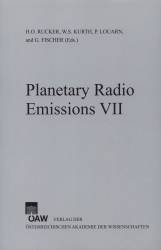
Planetary Radio Emissions VII, pp. 367-372, 2011/12/28
Proceedings of the 7th International Workshop on Planetary, Solar and Heliospheric Radio Emissions held at Graz, Austria, September 15–17, 2010

We report on the observation of powerful (fluxes are larger than 10-19 W/m2Hz) solar type III bursts at frequencies of 10-30 MHz using the radio telescope UTR - 2. The properties of powerful type III bursts observed in July 2002 (163 bursts) and August 2002 (231 bursts) were analysed. It was determined that the majority of these bursts were observed on days when an active region was located near the central meridian or at longitudes of 400 - 600 to the east or west of the central meridian. All of these bursts drift from high frequency to low with frequency drift rates of 1-2.5 MHz/s in most cases. We note that the frequency drift rate of these bursts increases linearly with frequency for all days of observation. This indicates that the solar corona above active regions shows an exponential density decrease with distance. The typical duration of the powerful type III bursts changes from 6 to 12 s. The instantaneous frequency widths of these bursts do not depend on the day of observation. There is a linear dependence between the average frequency width and frequency. The implication of these observations are discussed in the frame of the plasma model for the type III bursts generation.